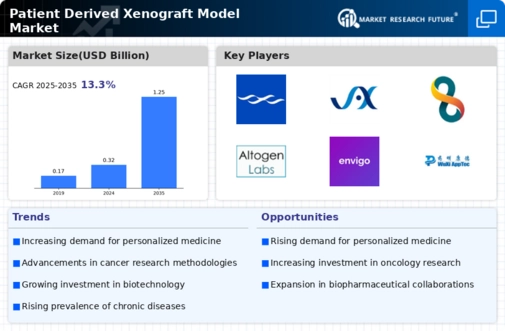Market Analysis
In-depth Analysis of Patient Derived Xenograft Model Market Industry Landscape
A number of factors are at work in the Patient-Derived Xenograft (PDX) Model Market that determine how it behaves in biotechnology and pharmaceutical research. This market is driven mainly by the need for more precise and predictive experimental models in drug discovery. These patient-derived xenograft models transplant human tumor tissue into immunodeficient mice, offering a valuable approach to examining cancer biology, assessing possible therapies, as well as developing personalized treatments.
Changes in medical study and technology have been crucial in shaping the PDX model market. PDX models are being developed further and used more widely. For this purpose, new technologies like gene editing or making smarter mouse lines are being employed. Also, there have been advancements in imaging tools and genetic analysis which have resulted in better PDX models. The latter enable scientists to understand better how tumors behave and provide a clearer picture of how drugs operate thus changing the market landscape.
Additionally, it is important to mention that the intensity of competition between CROs, biotech firms and research universities is another major factor affecting these markets. Fierce competition foster creativity; hence businesses are currently concentrating on producing PDX models that closely replicate actual tumors as well as their response towards treating them. Therefore companies engage new partnerships, collaborations and deals so as to grow their PDX model portfolios, enhance their research capabilities and gain an advantage over their peers within this preclinical space.
The preferences of drug manufacturers along with pharmaceutical researchers play a significant role influencing the growth of PDX model market. Researchers as well as drug makers may prefer PDX models because they accurately reflect differences observed among human cancers predicting drug efficacy or toxicity reliably. Additionally; for companies looking to leverage external expertise, working with CROs who offer specialized services on PDXs plus comprehensive data analysis may be ideal option available for them since they can get better insights from cancer diagnostics experts when evaluating biomarkers for clinical trials. To achieve this, companies in the PDX model industry invest in model development, process improvements as well as offer a range of services tailored to drug development programs.
Finally, the composition of cancer research and drug development sectors influences this market. The use of PDX models for applied research is changing the market as new trends in precision medicine and immuno-oncology are supporting their adoption. The availability of appropriate PDX models can affect both study decisions and success rates in pharmaceutical projects during drug development.













Leave a Comment